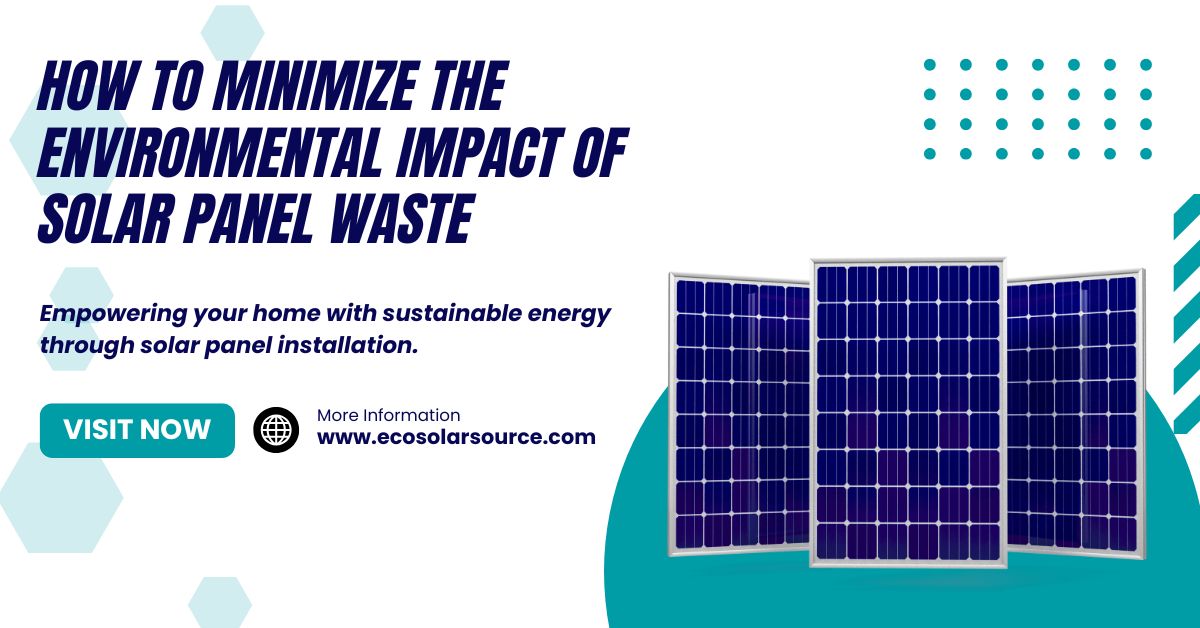How to Minimize the Environmental Impact of Solar Panel Waste
Learn the details about How to Minimize the Environmental Impact of Solar Panel Waste and effective strategies for minimizing the environmental impact of solar panel waste. This guide covers sustainable practices to manage end-of-life solar panels, including recycling, repurposing materials, and supporting innovations in solar technology design.
Discover how extended producer responsibility (EPR) programs, eco-friendly manufacturing, and proper disposal methods can significantly reduce waste. By implementing these approaches, we can enhance solar energy’s sustainability, ensure cleaner ecosystems, and maximize the positive benefits of renewable energy sources. Equip yourself with the knowledge to make solar panels greener and promote a sustainable future with minimal waste impact.
Table of Contents
How to Minimize the Environmental Impact of Solar Panel Waste
Solar energy is one of the most promising solutions for reducing greenhouse gas emissions and mitigating climate change. With the rapid growth in solar energy adoption globally, billions of solar panels are installed on rooftops, in solar farms, and even in infrastructure projects. However, as these panels reach the end of their lifecycle, a new challenge emerges: solar panel waste.
Solar panels are typically designed to last 25–30 years, and given the boom in solar installations that began in the early 2000s, we are approaching a significant waste surge. The International Renewable Energy Agency (IRENA) estimates that by 2050, the cumulative volume of solar panel waste could reach 78 million metric tons globally. If not handled properly, this waste poses serious environmental risks due to potentially hazardous materials in the panels. Thus, finding sustainable and effective ways to manage and minimize the environmental impact of solar panel waste is essential.
In this guide, we’ll explore why solar panel waste is a pressing issue, its potential environmental impacts, and strategies for minimizing it through innovative recycling techniques, policy initiatives, and consumer action.
Understanding Solar Panel Waste

1. Composition of Solar Panels
Solar panels are composed of a variety of materials, including:
- Silicon: The most common material used in solar cells, crucial for photovoltaic (PV) energy conversion.
- Metals: Silver, aluminum, and other metals are often used to construct solar panels, with copper and rare earth metals found in some panels.
- Glass: Glass makes up a large portion of solar panels and provides durability and protection to the cells.
- Plastics and Polymers: Often used as encapsulants to protect solar cells from moisture and other environmental factors.
2. Why Solar Panel Waste Is an Environmental Concern
As solar panels age, their effectiveness diminishes. While they can still function, their output declines, leading many systems to be retired prematurely. Improper disposal of solar panels poses a risk due to:
- Toxic Components: Solar panels may contain hazardous substances, such as cadmium, lead, and selenium. If these materials leach into soil or water, they can have detrimental effects on ecosystems and human health.
- Landfill Overflow: As panels are bulky, they contribute to landfill overflow, which is problematic given the large projected volume of solar panel waste.
- Resource Scarcity: Many materials used in solar panels are finite and valuable. By not recycling these materials, we lose the opportunity to repurpose and reduce the need for new extractions.
Strategies for Minimizing Solar Panel Waste
1. Recycling Solar Panels
Recycling is one of the most effective ways to mitigate solar panel waste. However, recycling solar panels can be complex due to the mix of materials. Here are some ways to optimize recycling:
- Thermal Recycling: In this method, panels are heated to break down and separate components. Metals and silicon can be recovered for reuse, while some polymers may be incinerated or repurposed.
- Mechanical Recycling: This approach involves crushing and shredding panels, then separating metals, glass, and silicon for reuse. Mechanical recycling is generally more eco-friendly but may result in lower purity levels for recycled silicon.
- Chemical Recycling: Chemical processes, such as acid leaching, can extract valuable metals and silicon with higher purity, though they may require careful handling to avoid environmental harm.
2. Promoting Extended Producer Responsibility (EPR)
Extended Producer Responsibility (EPR) policies mandate that manufacturers take responsibility for the disposal or recycling of their products. Applying EPR to the solar industry can incentivize manufacturers to design panels with recycling in mind and invest in recycling infrastructure.
- Design for Recycling: By choosing easily recyclable materials and minimizing hazardous content, manufacturers can make recycling more efficient.
- Manufacturer Take-Back Programs: Some companies have initiated take-back programs to recycle their old panels, reducing the burden on landfills and consumers.
3. Advancing Recycling Technology
New technologies in solar recycling have been emerging, making it easier and more cost-effective to recycle panels. Key innovations include:
- Laser Technology for Separation: Lasers can now help separate different layers of a solar panel with precision, which allows for more efficient material recovery.
- High-Efficiency Separation Techniques: New techniques improve the separation of silicon and metals, yielding higher-quality recycled materials and reducing the overall recycling cost.
- Automated Disassembly Lines: Automation in disassembling panels allows for faster processing and safer handling of toxic components, reducing human risk.
3. Second Life and Repurposing
Another option is giving solar panels a “second life” by repurposing them for lower-power applications. Retired panels with diminished efficiency can still be used in:
- Community Projects: Solar panels that no longer meet utility standards can be repurposed for community projects where lower efficiency is sufficient.
- Off-Grid Applications: Panels that still produce some energy can be used in off-grid applications, such as powering small equipment, remote weather stations, or providing backup power.
- Developing Regions: Reusing old panels in areas with limited energy access can provide an affordable power source without relying on new materials.
Policy and Regulatory Approaches to Solar Panel Waste

1. Legislative Action on Solar Waste Management
Governments around the world are starting to recognize the need for solar waste management policies. For example:
- European Union (EU): The EU has implemented the Waste Electrical and Electronic Equipment (WEEE) Directive, which requires solar panel manufacturers to finance the collection, treatment, and recycling of panels.
- United States: While there is no federal regulation specific to solar waste, states like California have taken proactive measures, classifying solar panels as universal waste and encouraging recycling.
2. Incentivizing Recycling and Repurposing
Tax incentives, grants, and other financial programs can encourage companies to invest in solar panel recycling and repurposing initiatives.
3. Global Standards for Solar Panel Recycling
The development of international standards for solar panel recycling and materials recovery can streamline recycling processes, making it easier and more cost-effective for companies and countries to manage solar waste sustainably.
The Role of Consumers in Minimizing Solar Panel Waste
1. Choosing Panels with End-of-Life Considerations
When purchasing solar panels, consumers can look for manufacturers who:
- Offer take-back programs or have clear end-of-life strategies.
- Use recyclable or easily separable materials.
- Have a track record of environmental responsibility.
2. Extending the Lifespan of Solar Panels
Routine maintenance can extend the life of solar panels, reducing the need for replacements:
- Regular Cleaning: Dirt and debris can reduce efficiency, so regular cleaning can help panels perform optimally.
- Monitoring Performance: Early detection of issues can allow for repairs, extending panel life.
- Upgrading Inverters: Often, an inverter upgrade can prolong the utility of a solar system without the need to replace panels.
3. Supporting Solar Recycling Programs
Consumers can participate in solar panel recycling programs, either through local facilities or by working with manufacturers who offer take-back options.
Future Directions in Solar Panel Waste Management

1. Innovations in Solar Panel Design
Future solar panel designs are likely to emphasize recyclability and durability. Trends may include:
- Thin-Film and Organic Panels: Organic photovoltaic cells (OPVs) are being developed with fewer toxic materials, which could reduce the environmental impact.
- Self-Healing Materials: Some new materials are being designed to self-heal, which could increase panel longevity and reduce waste.
2. Industry-Wide Collaboration on Recycling Solutions
Collaborative efforts, such as industry associations focused on solar waste management, can drive innovation in recycling and repurposing technologies.
3. Development of a Circular Solar Economy
Building a circular economy around solar technology, where materials are consistently reused and waste is minimized, is the ultimate goal. Achieving this requires collaboration across industries, policy reform, technological innovation, and consumer awareness.
FAQs About How to Minimize the Environmental Impact of Solar Panel Waste
The rise in solar energy adoption is essential for combating climate change, but it also introduces new challenges regarding waste. By investing in recycling technologies, supporting policy changes, and encouraging responsible consumer behavior, we can minimize the environmental impact of solar panel waste. Through coordinated efforts from manufacturers, governments, and consumers, we can ensure that solar energy remains not only a renewable but also a sustainable solution for generations to come.
Click here to learn more about How to Minimize the Environmental Impact of Solar Panel Waste
Click here to learn more about Which Types of Renewable Energy Sources Are Used in India

